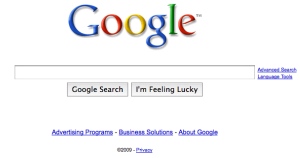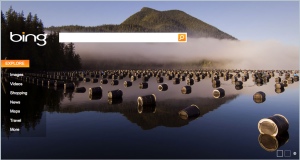
At the outset the frame of defacement is fitted for the conversation. Google’s SideWiki opens the door to an exploration of free speech, owned speech, unadulterated speech, graffiti, the Network as place and home, and what it is to write and read. Of course, the conversation isn’t really about SideWiki at all. Let’s start our exploration with writing.
A text is always already situated within a network of intertextuality. While we think we “have our say,” we assemble our sentences from an ocean of influences and predecessors. The connections stretch out back into history and as it tumbles out, our writing becomes fodder for the next person with something to say. Our writing and speech are never solely ours. The difference is that within the Network, the connections can be made visible. SideWiki, Disqus and Echo all aggregate and surface textual connections. Just as I might cut two related stories from two different newspapers and put them in a single manila folder.

The aggregated view exposes the edges of each piece—it’s that juxtaposition that activates the points of contention, the volatile elements of meaning, the interesting bits. To some extent, this is what we do when incorporate citations or quotations into our writing. We expose the fragmentary edges of a text to our commentary.
We like to talk about a two-way web, or a read/write web— but we still conceive of this as a half-duplex transmission. The revolution seems to be in the ever broader distribution of writing. We’ve yet to understand a full-duplex read/write— a writing that is also reading; and a reading that is also writing. The same pencil both writes and reads. McLuhan talked about this transition in terms of the old media becoming the content of the new media.

The act of reading is re-writing. The text is torn, ruptured and cut to make room for the commentary, associations, orthogonal meanderings, debate, and dialogue. Reading is always already all this. Writing itself could be called a form of close reading. Sometimes there’s ink in the pen, other times we let the thoughts fade away. We even employ Tmesis to insert our commentary into the middle of a word, for example: I abso-bloody-lutely have the right look at your website using Google’s SideWiki.
Roland Barthes describes how we read to create a more pleasurable engagement with the text in his short book: ‘The Pleasure of the Text:’
…we do not read everything with the same intensity of reading; a rhythm is established, casual, unconcerned with the integrity of the text; our very avidity for knowledge impels us to skim or to skip certain passages (anticipated as “boring”) in order to get more quickly to the warmer parts of the anecdote (which are always its articulations: whatever furthers the solution of the riddle, descriptions, explanations, analyses, conversations; doing so, we resemble a spectator in a nightclub who climbs onto the stage and speeds up the dancer’s striptease, tearing off her clothing, but in the same order, that is: on the one hand respecting and on the other hastening episodes of the ritual (like a priest gulping down his Mass). Tmesis, source or figure of pleasure, here confronts two prosaic edges with one another; it sets what is useful to a knowledge of the secret against what is useless to such knowledge; tmesis is a seam or flaw resulting from a simple principle of functionality; it does not occur at the level of the structure of languages but only a the moment of their consumption; the author cannot predict tmesis: he cannot choose to write what will not be read. And yet, it is the very rhythm of what is read and what is not read that creates the pleasure of the great narratives: has anyone ever read Proust, Balzac, War and Peace, word for word? (Proust’s good fortune: from one reading to the next, we never skip the same passages.)
The question of reading as re-writing reaches its pinnacle with the transition from quotation to the practice of superimposition. For instance, imagine a program that alters the contents of a browser through adding new layers based on a personal context— I remix on the fly, in real time. Perhaps for every image of Robert Scoble that loads into my browser, a mustache layer is added to the appropriate spot in the image. If I found this to be a valuable or amusing way to consume the web— I have every right to do so. We saw something like this with the recent Kanye West site rewriting. A very amusing way to view the web. The Medium is the Remix:
The Network is becoming dynamic from both sides of the glass. Web servers connected to data stores created the possibility of dynamic pages at the server level. When combined with AJAX techniques, the dynamic set of pages becomes a viewport into which various dynamic data resources are called. A form of personalization can be created from the server’s data store based on the assignment of a unique identity to the user. But as far as this stack of techniques has come from the flat HTML page, it’s still a server-centric stack of technologies and techniques. It’s dynamic from the server’s side of the glass.
It’s here that the actual topic of discussion begins to emerge: the possibility of a dynamism from the user’s side of the glass. Perhaps we begin by painting mustaches on Robert Scoble, but we quickly move to the creation of a personal context that superimposes our purposes on to the web that passes through the browser viewport.
The technologies that make a dynamic web possible from the user’s side of the glass are already well under way. The Firefox greasemonkey plugin exposed the potential of reading/writing browser viewport content. The information card, the selector, KNS and the action card make up the foundational elements of a new ecosystem for the user’s side of the glass. Here’s Craig Burton:
Web augmentation is an incredible phenomenon that we are just beginning to understand and use. There is a spectrum of tools available to accomplish various levels of augmentation. I only talk about two of those here. Greasemonkey and Action Cards.
I stand by my position that Action Card web augmentation changes everything. And that greasemonkey—at its most lofty view—is a mere harbinger of the real thing. Greasemonkey lets you do basic web augmentation with lots of potential problems and drawbacks.
Action Cards—the combination of the selector-based information card, KNS, and cloud-based data is elegant, well thought out, and well architected capable of making long lasting significant changes to the Internet.
Phil Windley provides the example of looking at Amazon.com search results with a superimposition of an indicator telling the user whether a particular book is available at a local library. The personal context might be: whatever I’m looking at, when a book is mentioned, let me know if it’s available at my local library. I might be entitled to discounts based on membership in an organization or club. That context could be made visible when I shop online. The potential for the mobile web is even greater.
The value of dynamism from both the client and server side on the image in the browser’s viewport has yet to be fully understood or imagined. We barely have the language to talk about it. The October 1st Gillmor Gang attempts to start a discussion about users writing to the browser from the client’s side of the glass.
We end, perhaps, where we began, with Windley’s Bill of Rights:
I claim the right to mash-up, remix, annotate, augment, and otherwise modify Web content for my purposes in my browser using any tool I choose and I extend to everyone else that same privilege.
Of course, rights are one thing and capability entirely another. That object floating in the glass between the server and the client is about to become an entirely new kind of collaboration.
3 Comments





